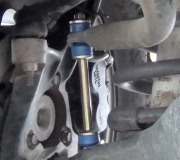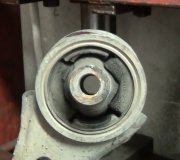Almost all of what you listed won't cause a vibration. First you have to determine if it's a continuous bouncing after hitting a bump in the road, if it's rotational, meaning the vibration is felt as one, two, or three bumps per wheel revolution, and whether it's felt in the car's seat or the steering wheel is oscillating. Also note if you feel it in the brake pedal.
A continuous bouncing is related to the weight of the tire, wheel, and lower control arm, and will not change with changes in vehicle speed. That's due to worn struts or shock absorbers. Since you replaced the struts already, along with all those other parts, let me suggest the commonly-overlooked causes. If you feel the vibration in the steering wheel, use a dial indicator with a heavy stand to measure the run out of the front wheels. I'll have to assume the wheels aren't bent in spite of not knowing how that was determined, but more commonly, when someone does a brake job or any other service that requires removing a brake rotor, improper cleaning can result in what looks like a bent wheel. There's access holes in the bearing hub, and water splashes through them and causes rust spots to build up on the backside of the rotor. Those spots of rust need to be cleaned off before machining an old rotor or reinstalling it. Same with the rust the forms along the outer perimeter of that hub. A piece of scale can break off and get wedged between the hub and rotor. That prevents the rotor from sitting squarely on the hub and will make the rotor and wheel wobble.
Same is true if a chunk of scale gets stuck between the wheel and rotor. That's much more common with cast wheels. Run out as little as.045" can cause an annoying vibration.
If you get three steering wheel oscillations per one wheel revolution, suspect a worn inner cv joint housing. I can describe how to inspect it for that but it requires taking the joint apart. Replacing the half shaft can actually make that worse because very often the person rebuilding a used shaft doesn't know how to check for that. You stand a very good chance of getting a bad one right out of the box. That won't happen with a new shaft, but those are horribly expensive. About the only way to get one of those is when the car is still under warranty and the manufacturer is supplying the parts.
If you see and / or feel a slight steering wheel oscillation at low speeds, as in when driving through a parking lot, suspect a broken tire belt. All mechanics are familiar with a broken belt that causes a tumor or huge raised spot to form on the tread, but there are other, more difficult things to look for.
Check the tire wear patterns too. Even though the car was aligned, if a worn part was overlooked that is involved with keeping the wheels in alignment, the alignment will change either after the alignment is done or just while the car is in motion.
Finally, measure the ride height. All alignment shops have a small book that shows where to take the measurements and what they should be for each model and year. Sagged suspension can set up vibrations. A lot of truck owners are familiar with that. It's real common on Ford full-size conversion vans with their added weight on the rear. They can develop a drive line vibration in as little as six months.
Wednesday, August 6th, 2014 AT 9:19 PM



